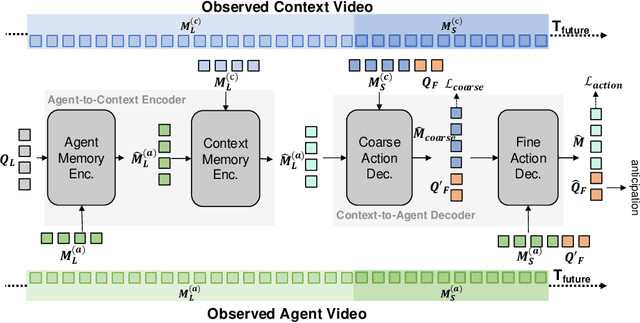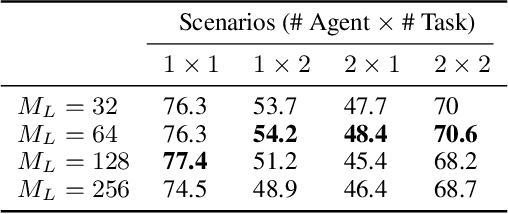Xinran Zhao
HiMemFormer: Hierarchical Memory-Aware Transformer for Multi-Agent Action Anticipation
Nov 03, 2024



Abstract:Understanding and predicting human actions has been a long-standing challenge and is a crucial measure of perception in robotics AI. While significant progress has been made in anticipating the future actions of individual agents, prior work has largely overlooked a key aspect of real-world human activity -- interactions. To address this gap in human-like forecasting within multi-agent environments, we present the Hierarchical Memory-Aware Transformer (HiMemFormer), a transformer-based model for online multi-agent action anticipation. HiMemFormer integrates and distributes global memory that captures joint historical information across all agents through a transformer framework, with a hierarchical local memory decoder that interprets agent-specific features based on these global representations using a coarse-to-fine strategy. In contrast to previous approaches, HiMemFormer uniquely hierarchically applies the global context with agent-specific preferences to avoid noisy or redundant information in multi-agent action anticipation. Extensive experiments on various multi-agent scenarios demonstrate the significant performance of HiMemFormer, compared with other state-of-the-art methods.
$\textit{GeoHard}$: Towards Measuring Class-wise Hardness through Modelling Class Semantics
Jul 17, 2024Abstract:Recent advances in measuring hardness-wise properties of data guide language models in sample selection within low-resource scenarios. However, class-specific properties are overlooked for task setup and learning. How will these properties influence model learning and is it generalizable across datasets? To answer this question, this work formally initiates the concept of $\textit{class-wise hardness}$. Experiments across eight natural language understanding (NLU) datasets demonstrate a consistent hardness distribution across learning paradigms, models, and human judgment. Subsequent experiments unveil a notable challenge in measuring such class-wise hardness with instance-level metrics in previous works. To address this, we propose $\textit{GeoHard}$ for class-wise hardness measurement by modeling class geometry in the semantic embedding space. $\textit{GeoHard}$ surpasses instance-level metrics by over 59 percent on $\textit{Pearson}$'s correlation on measuring class-wise hardness. Our analysis theoretically and empirically underscores the generality of $\textit{GeoHard}$ as a fresh perspective on data diagnosis. Additionally, we showcase how understanding class-wise hardness can practically aid in improving task learning.
$\texttt{MixGR}$: Enhancing Retriever Generalization for Scientific Domain through Complementary Granularity
Jul 15, 2024



Abstract:Recent studies show the growing significance of document retrieval in the generation of LLMs, i.e., RAG, within the scientific domain by bridging their knowledge gap. However, dense retrievers often struggle with domain-specific retrieval and complex query-document relationships, particularly when query segments correspond to various parts of a document. To alleviate such prevalent challenges, this paper introduces $\texttt{MixGR}$, which improves dense retrievers' awareness of query-document matching across various levels of granularity in queries and documents using a zero-shot approach. $\texttt{MixGR}$ fuses various metrics based on these granularities to a united score that reflects a comprehensive query-document similarity. Our experiments demonstrate that $\texttt{MixGR}$ outperforms previous document retrieval by 24.7% and 9.8% on nDCG@5 with unsupervised and supervised retrievers, respectively, averaged on queries containing multiple subqueries from five scientific retrieval datasets. Moreover, the efficacy of two downstream scientific question-answering tasks highlights the advantage of $\texttt{MixGR}$to boost the application of LLMs in the scientific domain.
Beyond Relevance: Evaluate and Improve Retrievers on Perspective Awareness
May 04, 2024



Abstract:The task of Information Retrieval (IR) requires a system to identify relevant documents based on users' information needs. In real-world scenarios, retrievers are expected to not only rely on the semantic relevance between the documents and the queries but also recognize the nuanced intents or perspectives behind a user query. For example, when asked to verify a claim, a retrieval system is expected to identify evidence from both supporting vs. contradicting perspectives, for the downstream system to make a fair judgment call. In this work, we study whether retrievers can recognize and respond to different perspectives of the queries -- beyond finding relevant documents for a claim, can retrievers distinguish supporting vs. opposing documents? We reform and extend six existing tasks to create a benchmark for retrieval, where we have diverse perspectives described in free-form text, besides root, neutral queries. We show that current retrievers covered in our experiments have limited awareness of subtly different perspectives in queries and can also be biased toward certain perspectives. Motivated by the observation, we further explore the potential to leverage geometric features of retriever representation space to improve the perspective awareness of retrievers in a zero-shot manner. We demonstrate the efficiency and effectiveness of our projection-based methods on the same set of tasks. Further analysis also shows how perspective awareness improves performance on various downstream tasks, with 4.2% higher accuracy on AmbigQA and 29.9% more correlation with designated viewpoints on essay writing, compared to non-perspective-aware baselines.
Fact-and-Reflection (FaR) Improves Confidence Calibration of Large Language Models
Feb 27, 2024Abstract:For a LLM to be trustworthy, its confidence level should be well-calibrated with its actual performance. While it is now common sense that LLM performances are greatly impacted by prompts, the confidence calibration in prompting LLMs has yet to be thoroughly explored. In this paper, we explore how different prompting strategies influence LLM confidence calibration and how it could be improved. We conduct extensive experiments on six prompting methods in the question-answering context and we observe that, while these methods help improve the expected LLM calibration, they also trigger LLMs to be over-confident when responding to some instances. Inspired by human cognition, we propose Fact-and-Reflection (FaR) prompting, which improves the LLM calibration in two steps. First, FaR elicits the known "facts" that are relevant to the input prompt from the LLM. And then it asks the model to "reflect" over them to generate the final answer. Experiments show that FaR prompting achieves significantly better calibration; it lowers the Expected Calibration Error by 23.5% on our multi-purpose QA tasks. Notably, FaR prompting even elicits the capability of verbally expressing concerns in less confident scenarios, which helps trigger retrieval augmentation for solving these harder instances.
Dense X Retrieval: What Retrieval Granularity Should We Use?
Dec 12, 2023Abstract:Dense retrieval has become a prominent method to obtain relevant context or world knowledge in open-domain NLP tasks. When we use a learned dense retriever on a retrieval corpus at inference time, an often-overlooked design choice is the retrieval unit in which the corpus is indexed, e.g. document, passage, or sentence. We discover that the retrieval unit choice significantly impacts the performance of both retrieval and downstream tasks. Distinct from the typical approach of using passages or sentences, we introduce a novel retrieval unit, proposition, for dense retrieval. Propositions are defined as atomic expressions within text, each encapsulating a distinct factoid and presented in a concise, self-contained natural language format. We conduct an empirical comparison of different retrieval granularity. Our results reveal that proposition-based retrieval significantly outperforms traditional passage or sentence-based methods in dense retrieval. Moreover, retrieval by proposition also enhances the performance of downstream QA tasks, since the retrieved texts are more condensed with question-relevant information, reducing the need for lengthy input tokens and minimizing the inclusion of extraneous, irrelevant information.
"Merge Conflicts!" Exploring the Impacts of External Distractors to Parametric Knowledge Graphs
Sep 15, 2023Abstract:Large language models (LLMs) acquire extensive knowledge during pre-training, known as their parametric knowledge. However, in order to remain up-to-date and align with human instructions, LLMs inevitably require external knowledge during their interactions with users. This raises a crucial question: How will LLMs respond when external knowledge interferes with their parametric knowledge? To investigate this question, we propose a framework that systematically elicits LLM parametric knowledge and introduces external knowledge. Specifically, we uncover the impacts by constructing a parametric knowledge graph to reveal the different knowledge structures of LLMs, and introduce external knowledge through distractors of varying degrees, methods, positions, and formats. Our experiments on both black-box and open-source models demonstrate that LLMs tend to produce responses that deviate from their parametric knowledge, particularly when they encounter direct conflicts or confounding changes of information within detailed contexts. We also find that while LLMs are sensitive to the veracity of external knowledge, they can still be distracted by unrelated information. These findings highlight the risk of hallucination when integrating external knowledge, even indirectly, during interactions with current LLMs. All the data and results are publicly available.
Thrust: Adaptively Propels Large Language Models with External Knowledge
Jul 19, 2023Abstract:Although large-scale pre-trained language models (PTLMs) are shown to encode rich knowledge in their model parameters, the inherent knowledge in PTLMs can be opaque or static, making external knowledge necessary. However, the existing information retrieval techniques could be costly and may even introduce noisy and sometimes misleading knowledge. To address these challenges, we propose the instance-level adaptive propulsion of external knowledge (IAPEK), where we only conduct the retrieval when necessary. To achieve this goal, we propose measuring whether a PTLM contains enough knowledge to solve an instance with a novel metric, Thrust, which leverages the representation distribution of a small number of seen instances. Extensive experiments demonstrate that thrust is a good measurement of PTLM models' instance-level knowledgeability. Moreover, we can achieve significantly higher cost-efficiency with the Thrust score as the retrieval indicator than the naive usage of external knowledge on 88% of the evaluated tasks with 26% average performance improvement. Such findings shed light on the real-world practice of knowledge-enhanced LMs with a limited knowledge-seeking budget due to computation latency or costs.
On Measuring the Intrinsic Few-Shot Hardness of Datasets
Nov 16, 2022Abstract:While advances in pre-training have led to dramatic improvements in few-shot learning of NLP tasks, there is limited understanding of what drives successful few-shot adaptation in datasets. In particular, given a new dataset and a pre-trained model, what properties of the dataset make it \emph{few-shot learnable} and are these properties independent of the specific adaptation techniques used? We consider an extensive set of recent few-shot learning methods, and show that their performance across a large number of datasets is highly correlated, showing that few-shot hardness may be intrinsic to datasets, for a given pre-trained model. To estimate intrinsic few-shot hardness, we then propose a simple and lightweight metric called "Spread" that captures the intuition that few-shot learning is made possible by exploiting feature-space invariances between training and test samples. Our metric better accounts for few-shot hardness compared to existing notions of hardness, and is ~8-100x faster to compute.
Beyond the Imitation Game: Quantifying and extrapolating the capabilities of language models
Jun 10, 2022Abstract:Language models demonstrate both quantitative improvement and new qualitative capabilities with increasing scale. Despite their potentially transformative impact, these new capabilities are as yet poorly characterized. In order to inform future research, prepare for disruptive new model capabilities, and ameliorate socially harmful effects, it is vital that we understand the present and near-future capabilities and limitations of language models. To address this challenge, we introduce the Beyond the Imitation Game benchmark (BIG-bench). BIG-bench currently consists of 204 tasks, contributed by 442 authors across 132 institutions. Task topics are diverse, drawing problems from linguistics, childhood development, math, common-sense reasoning, biology, physics, social bias, software development, and beyond. BIG-bench focuses on tasks that are believed to be beyond the capabilities of current language models. We evaluate the behavior of OpenAI's GPT models, Google-internal dense transformer architectures, and Switch-style sparse transformers on BIG-bench, across model sizes spanning millions to hundreds of billions of parameters. In addition, a team of human expert raters performed all tasks in order to provide a strong baseline. Findings include: model performance and calibration both improve with scale, but are poor in absolute terms (and when compared with rater performance); performance is remarkably similar across model classes, though with benefits from sparsity; tasks that improve gradually and predictably commonly involve a large knowledge or memorization component, whereas tasks that exhibit "breakthrough" behavior at a critical scale often involve multiple steps or components, or brittle metrics; social bias typically increases with scale in settings with ambiguous context, but this can be improved with prompting.
 Add to Chrome
Add to Chrome Add to Firefox
Add to Firefox Add to Edge
Add to Edge